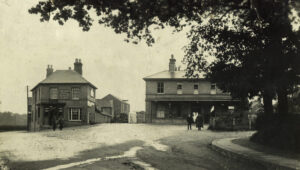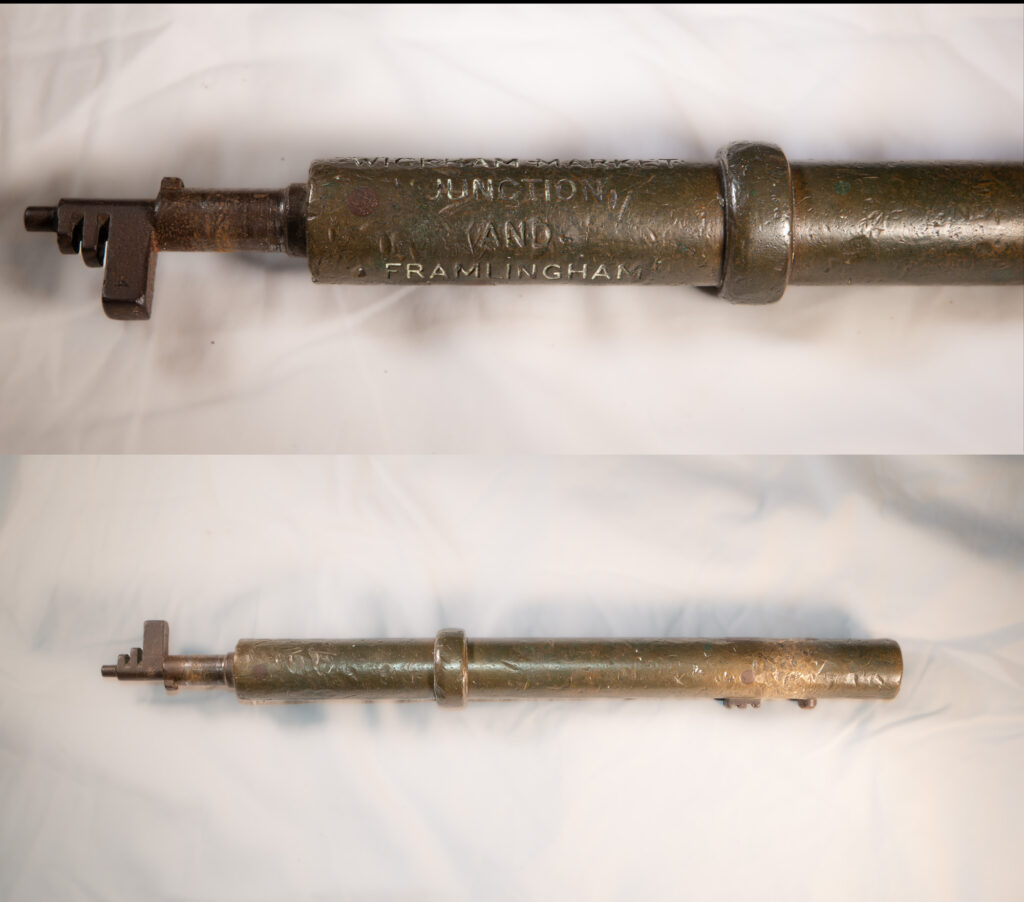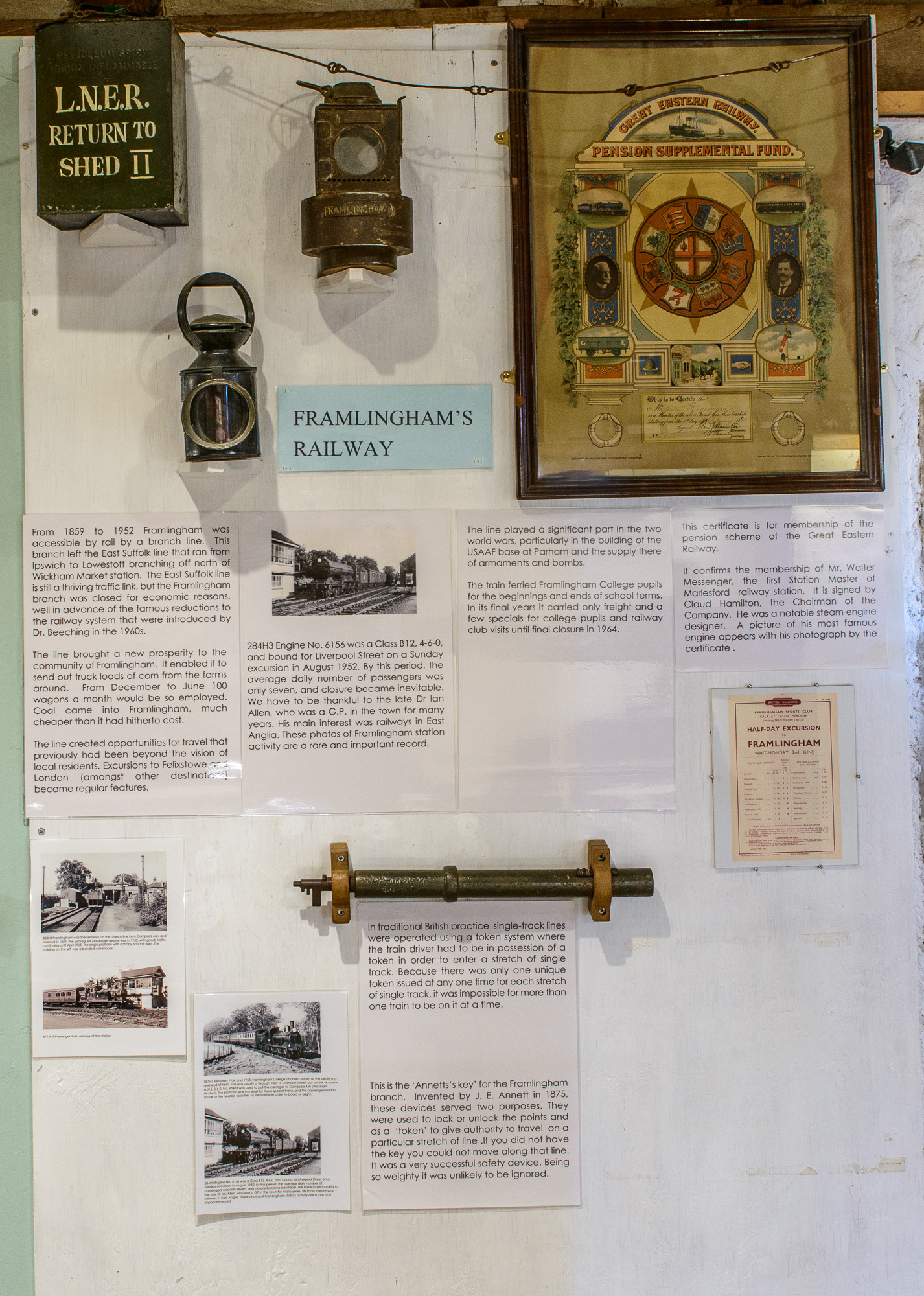
Framlingham was the terminus of a 6-mile branch line connecting to the East Suffolk Line just North of Wickham Market Station (which is actually at Campsea Ashe!). The Lanman Museum has a number of artefacts and documents from the railway on display.
The line was built by the East Suffolk Railway, and was officially opened on 1st June 1859. At that time the East Suffolk Line was itself incomplete, and trains from Framlingham could run only as far as Woodbridge.
Wikipedia records:
The Ipswich Journal of 4 June 1859 reported on the opening on the official opening day: “The bells rang merrily throughout the day, a cricket match was played, and tea was provided by Mr. John Pipe of the Crown Inn, in his usual style, of which 40 of the gentry and inhabitants of the town partook; appropriate speeches were made, songs sung, and a merry and convivial evening spent.” Unfortunately an evening concert at the Corn Exchange was cancelled as the band leader Edward Plantin was involved in a serious accident at the station and died of his injuries a few days later.
(Wikipedia https://en.wikipedia.org/wiki/Framlingham_branch)

There were intermediate stations at Parham and Marlesford, and in later years a halt was built at Hacheston. The line was relatively flat, with a few sections of embankment near Framlingham.
One section of embankment is still visible, terminating abruptly after a bridge. “It’s called the Bridge that Leads to Nowhere” said one old boy in the pub. “That’s because it’s a bridge. And it don’t go nowhere.”
Framlingham was an important local railhead for agricultural traffic; mainly grain, but also for cattle. It enabled Framlingham to send truck loads of grain from the a wide surrounding area, and up to 100 wagon-loads a month left Framlingham. Agricultural freight was brought from as far as Laxfield to the North, although after the Mid Suffolk Light Railway was opened in 1908, that northern traffic was lost to that “new” railway.

Both passenger and goods trains ran on the line, and although like most rural branch lines traffic was never heavy, the line was reasonably well used until the 1930s. For most of the life of the railway, five trains ran each way on weekdays, with two on Sundays. By the time of the 1922 Bradshaw timetable, the Sunday service had stopped, and some time later the weekday service was reduced to four trains each way.
“Specials” were run for excursions to destinations including Felixstowe and London, and school trains ran for Framlingham College at start and end of school terms. Word has it that the School Specials were not popular with the train cleaning and maintenance staff for the state of the trains after the pupils had left. A scurrilous rumour, I’m sure!

In later years, use declined as both passengers and freight increasingly used road transport. Passenger services ended in 1952 after the last train: the 6:52pm on Saturday 1st November. More than 500 people travelled on the last train, which had five additional carriages.
One passenger apparently achieved a life-long ambition to pull the emergency cord and not incur the (at the time) steep fine of £5!
To record the final journey, The Daily Telegraph had a piece entitled “The Flier Lets off Steam for the Last Time”:
Carrying passengers dressed in Victorian and Edwardian style, to whom hot punch was served, the “Framlingham Flyer” ended on Saturday evening its 93 years of service over the seven miles of rail between Wickham Market and Framlingham, Suffolk. With a laurel wreath over its funnel and carrying more passengers than it usually does in a month, the “Flier” was cheered by hundreds of people along the track. Villagers set off fireworks as the train passed by.
After that last regular passenger journey, the line remained open for daily freight services and few specials until 19th April 1965, when the line closed to all traffic.
The station buildings are now retail outlets, and the station hotel is a popular pub. Some of the path of the railway can still be discerned, although most is on private land, and much has returned to agricultural use (or in some cases, built on).
References
- There are a number of articles on Framlingham’s railway in the Framlingham History Society Newsletters and Journals, for example Third Series No. 12, April 2001. See https://framlinghamhistory.uk/newsletters-and-journals/
- Wikipidia: https://en.wikipedia.org/wiki/Framlingham_branch







